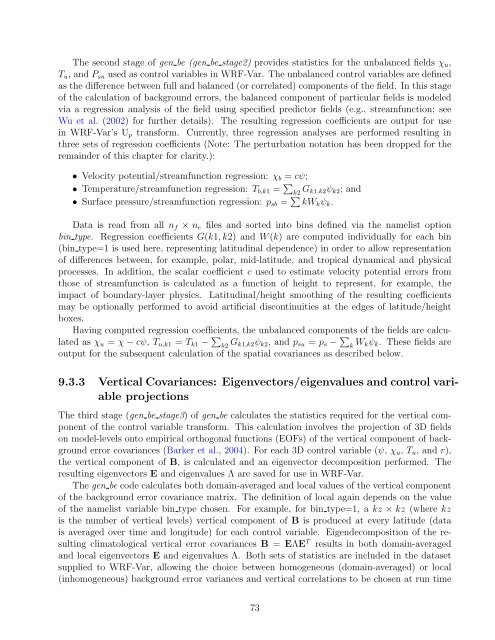Advanced Research WRF (ARW) Technical Note - MMM - University ...
Advanced Research WRF (ARW) Technical Note - MMM - University ...
Advanced Research WRF (ARW) Technical Note - MMM - University ...
You also want an ePaper? Increase the reach of your titles
YUMPU automatically turns print PDFs into web optimized ePapers that Google loves.
The second stage of gen be (gen be stage2) provides statistics for the unbalanced fields χu,<br />
Tu, and Psu used as control variables in <strong>WRF</strong>-Var. The unbalanced control variables are defined<br />
as the difference between full and balanced (or correlated) components of the field. In this stage<br />
of the calculation of background errors, the balanced component of particular fields is modeled<br />
via a regression analysis of the field using specified predictor fields (e.g., streamfunction; see<br />
Wu et al. (2002) for further details). The resulting regression coefficients are output for use<br />
in <strong>WRF</strong>-Var’s Up transform. Currently, three regression analyses are performed resulting in<br />
three sets of regression coefficients (<strong>Note</strong>: The perturbation notation has been dropped for the<br />
remainder of this chapter for clarity.):<br />
• Velocity potential/streamfunction regression: χb = cψ;<br />
• Temperature/streamfunction regression: Tb,k1 = <br />
k2 Gk1,k2ψk2; and<br />
• Surface pressure/streamfunction regression: psb = kWkψk.<br />
Data is read from all nf × ne files and sorted into bins defined via the namelist option<br />
bin type. Regression coefficients G(k1, k2) and W (k) are computed individually for each bin<br />
(bin type=1 is used here, representing latitudinal dependence) in order to allow representation<br />
of differences between, for example, polar, mid-latitude, and tropical dynamical and physical<br />
processes. In addition, the scalar coefficient c used to estimate velocity potential errors from<br />
those of streamfunction is calculated as a function of height to represent, for example, the<br />
impact of boundary-layer physics. Latitudinal/height smoothing of the resulting coefficients<br />
may be optionally performed to avoid artificial discontinuities at the edges of latitude/height<br />
boxes.<br />
Having computed regression coefficients, the unbalanced components of the fields are calculated<br />
as χu = χ − cψ, Tu,k1 = Tk1 − <br />
k2 Gk1,k2ψk2, and psu = ps − <br />
k Wkψk. These fields are<br />
output for the subsequent calculation of the spatial covariances as described below.<br />
9.3.3 Vertical Covariances: Eigenvectors/eigenvalues and control variable<br />
projections<br />
The third stage (gen be stage3) of gen be calculates the statistics required for the vertical component<br />
of the control variable transform. This calculation involves the projection of 3D fields<br />
on model-levels onto empirical orthogonal functions (EOFs) of the vertical component of background<br />
error covariances (Barker et al., 2004). For each 3D control variable (ψ, χu, Tu, and r),<br />
the vertical component of B, is calculated and an eigenvector decomposition performed. The<br />
resulting eigenvectors E and eigenvalues Λ are saved for use in <strong>WRF</strong>-Var.<br />
The gen be code calculates both domain-averaged and local values of the vertical component<br />
of the background error covariance matrix. The definition of local again depends on the value<br />
of the namelist variable bin type chosen. For example, for bin type=1, a kz × kz (where kz<br />
is the number of vertical levels) vertical component of B is produced at every latitude (data<br />
is averaged over time and longitude) for each control variable. Eigendecomposition of the resulting<br />
climatological vertical error covariances B = EΛE T results in both domain-averaged<br />
and local eigenvectors E and eigenvalues Λ. Both sets of statistics are included in the dataset<br />
supplied to <strong>WRF</strong>-Var, allowing the choice between homogeneous (domain-averaged) or local<br />
(inhomogeneous) background error variances and vertical correlations to be chosen at run time<br />
73
















